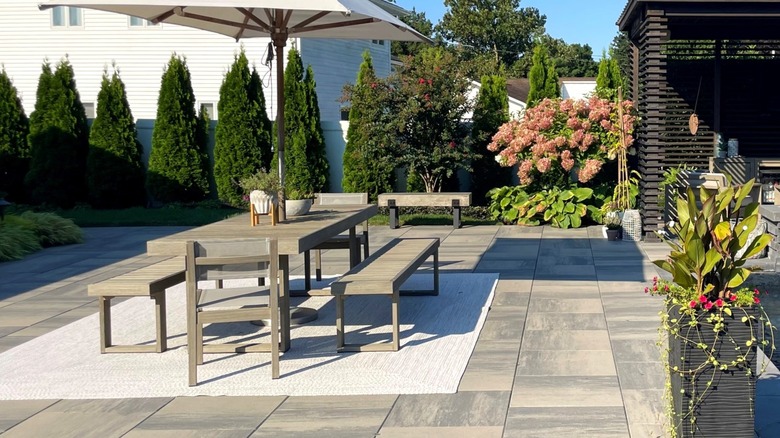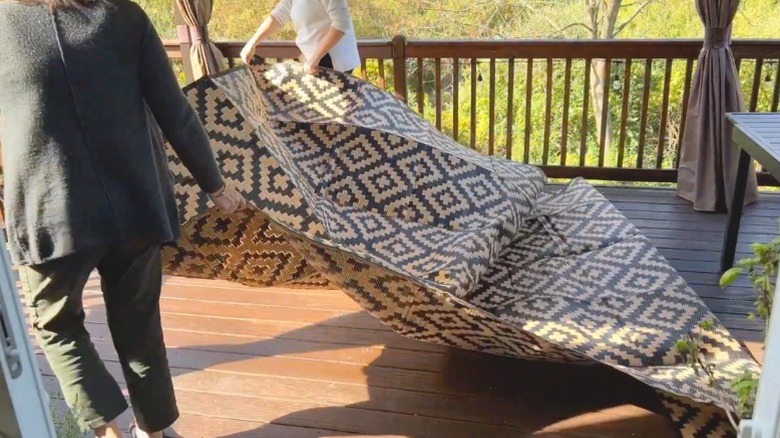How To Properly Clean An Outdoor Plastic Straw Rug
Given how they combine the resilience you need with the aesthetics of a traditional straw rug, you have more than enough reasons to consider an outdoor plastic straw rug for your patio. The comfortable, woven surface typically consists of polypropylene, providing dependable durability against mold, moisture, and other outdoor hazards for long-term performance. What many forget, though, is the construction is only half the equation. To keep your plastic straw rug looking and feeling fresh, cleaning and maintenance are just as vital as buying a high-quality product.
Managing outdoor plastic straw rugs is, thankfully, not unlike cleaning and maintaining outdoor rugs in any other style. Spot clean and deodorize stains with a teaspoon of mild dish liquid or vinegar mixed with a cup of warm water. Vinegar is particularly useful for mold and mildew. Commercial cleaners can also work, but read the manufacturer's care instructions and spot-test anything new in an inconspicuous area to check for damage or discoloration. Avoid harsh chemicals — they're often unnecessary, and though polypropylene can handle many substances, many other chemicals can degrade it. Milder solutions will also be easier on nearby vegetation that might encounter runoff.
Dab your cleaner to remove the stain, or use a soft brush to gently scrub it away. Always rinse thoroughly to get rid of any remaining soap because the residue can attract dirt and ruin the look in a flash. You'll also need to maintain your rug properly and give it regular washes with your garden hose or pressure washer if you want to ensure its longevity.
How to clean an outdoor plastic straw rug the right way
One of the easiest ways to properly clean your outdoor plastic straw rug is with a hose or pressure washer. Cleanability is a key advantage of these rugs, so you'll generally only need a drop or two of mild dish liquid in a few cups of warm water. The less you use, the easier it will be to rinse completely free of soap residue.
Clean both sides of the rug. When using your pressure washer, sweep the sprayer slowly across the surface. Move it along the rug's length and width to get between all of the woven fibers. For extra-dirty rugs (or if you're using a garden hose), you can also use a soft-bristled brush to dig out grime. Work in a grid pattern to thoroughly cover every section. You can also make a cleaning paste with baking soda and a bit of water to gently scrub out particularly tricky spots.
Once clean, rinse the rug thoroughly, and hang it up to dry. Plastic straw rugs are typically made to be UV-resistant, but check the manufacturer's directions before leaving it in the sun. Rotate it at least once to help it dry evenly. Ideally, it should lay flat or hang from a clothesline to maintain its shape. Let the rug dry for several hours before storing it or putting it back to prevent any chance of mold or mildew popping back up.
Proper maintenance to make your plastic straw rug last
Other than the occasional touch-ups and the deep cleanings you should do once or twice annually, you should aim for frequent light cleaning and proper maintenance when using and storing your plastic straw rug. Sweep or vacuum the rug at least once weekly. Turn off the beater bar, and use a soft brush attachment on the nozzle if possible. You can shake the rug instead for convenience, or hang it over your deck rail to beat it clean. Treat stains as soon as you notice them. If possible, you should also rotate the rug occasionally to help even out the wear from foot traffic, sunlight, and the elements.
When it's time to store your outdoor rug for the winter, keep it elevated in a dry, sheltered space to prevent moisture buildup. For optimal protection, consider wrapping it in a heavy-duty plastic bag or tarp to keep pests and water out. It'll be ready to use when you unwrap it, needing minimal cleaning to start the new season. Wash your deck or patio surface before putting the rug back down, and use adhesive corner grips, weights, or stakes to hold your rug in place. With the rug weighted on the corners, you'll keep it from blowing around and make it harder for dirt and debris to migrate under it.

